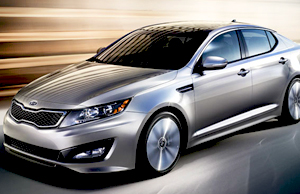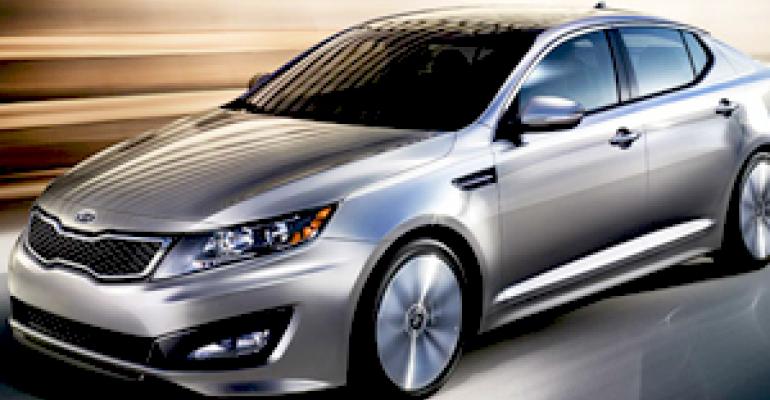
Highlights of the year’s major events affecting the Hyundai-Kia Group:
• South Korea’s Hyundai-Kia Automotive Group sells a total 894,496 vehicles in the U.S. in 2010, just 14,074 units short of Nissan, which generally places third among best-selling Asian auto makers in the market after Toyota and Honda.
It is the smallest annual margin ever between the Asian competitors, WardsAuto data shows. Individually, Hyundai sold 538,228 vehicles and Kia 356,268, both all-time records.
• Kia shows a boxy concept van, the KV7, which could spawn a replacement for the aging Sedona minivan, at January’s North American International Auto Show in Detroit. A key design feature is the lack of a B-pillar on the passenger side, creating a large entry point to the rear of the vehicle, which features reclaimed teak flooring and swivel seats.
• Hyundai-Kia announces a combined 2011 global sales goal of 6.33 million units, up 10% from the 5.75 million the two brands sold jointly worldwide in 2010.
• Hyundai retails its Equus large near-luxury sedan via select U.S. dealers. Those wishing to sell the car will be required to provide standalone stores and agree to segment their showrooms by purchasing kiosks and special flooring, as well as a higher level of customer service such as home and office demonstrations of the car.
The showroom-within-a-showroom scheme that the Equus shares with the Genesis mid-large near-luxury sedan garners Hyundai 2,568 Equus sales through October, nearing the high end of the 1,000-3,000 Hyundai hoped to sell annually in the U.S.
• Kia sees consumer interest in its Optima midsize sedan soar after National Basketball Assn. player Blake Griffin dunks over the car during February’s NBA All-Star weekend in Los Angeles. The auto maker, which is an official sponsor of the NBA, quickly incorporates the feat into a commercial and later brings in Griffin as a brand spokesman.

• Kia continues its 2-year involvement with motorsports, with the Forte Koup racing in the Grand-Am Challenge Series in the Street Tuner class and the Kia-Kinetic Motorsports team finishing first in races in April and June. At the season’s close in September, the Kia-Kinetic team wins the Grand-Am Road Racing championships with top honors for driver and team.
• The U.S. hybrid versions of the Hyundai Sonata and Kia Optima midsize sedans see delays, with volumes arriving at dealers in midyear. Hyundai blames the Sonata’s postponement on a late decision to remove a switch that disables the car’s noisemaker for blind pedestrians. The Optima Hybrid, originally set for a January launch, goes on sale in coastal states during summer, with wider availability pegged for fall.
• Kia avoids a labor strike for the second straight year by ratifying a new contract with the Korea Metal Workers Union. With the August approval, Kia workers accept terms they initially rejected in July, including a 90,000 won ($78) monthly salary increase.
The difference between the rejected and accepted deal is the addition of scholarships for children whose Kia-employed parents died in traffic accidents. Hyundai workers later ratify a similar pact, marking the third year in a row such a feat is accomplished without a strike.
• Hyundai-Kia top Honda-Acura U.S. sales in May for the first time, with 107,426 combined deliveries, compared with Honda’s 90,773. While the Korean brands make headway against some earthquake-affected Japanese brands in the year, they are unable to top Toyota monthly deliveries because of their own inventory shortages as consumer demand surges.
• Hyundai U.S. CEO John Krafcik says a new North American plant is being debated internally, but believes the auto maker can squeeze out another 30,000 vehicles in the year from its 300,000-unit capacity Montgomery, AL, plant by increasing line speed.
Special Coverage
 State of Industry: North America
State of Industry: North America
• Kia invests $100 million in its West Point, GA, facility to add 60,000 units of annual capacity for the Optima sedan. The sedan launches production at the plant in early September, joining the Kia Sorento and Hyundai Santa Fe cross/utility vehicles.
• Hyundai’s funky 3-door Veloster coupe that bowed at the Detroit auto show in January goes on sale in the U.S. in September, after earlier debuts in Korea and Europe. The unusual coupe has a third small, rear-hinged door on the passenger side for easier access to the back seats.
Special Coverage
 2011 Year In Review
2011 Year In Review
It is powered by the same 1.6L 138-hp direct-injected 4-cyl. gasoline engine used in the next-generation Hyundai Accent and Kia Rio subcompacts already on sale. Talk quickly turns to a turbocharged version of the Veloster, which Hyundai later confirms for 2012.
• Hyundai debuts its BlueLink telematics system in the U.S. in select models, with Kia’s delayed UVO infotainment system launching in the year as well. BlueLink has three distinct tiers, ranging from a base package with automatic collision notification and 911 dialing to a suite of technologies including turn-by-turn navigation and restaurant ratings.
UVO has no subscription fee and is optional on higher grades of select Kia models. It has storage for up to 250 songs on a 1GB hard drive, Bluetooth connectivity and a rear-view camera.
It is not yet compatible with navigation but a future version, which Kia shows select journalists in August, will be added. It will feature a large, touch-screen display with smartphone and tablet-like swiping for selections.
• Through October, Hyundai-Kia is pacing its first 1 million-unit year ever in the U.S. Hyundai predicts its Sonata sedan will hit 200,000-unit sales for the first time in 2011, putting it in a select high-volume group that includes the Toyota Camry, Honda Accord and Ford Fusion.
• Hyundai President and co-CEO Steve S. Yang resigns unexpectedly Oct. 1 for personal reasons. Yang is credited with bringing Hyundai through the recent global recession and increasing market share in Europe and North America.
He is replaced by two longtime Kia executives: Choong Ho Kim, 60, who will head up the business-strategy planning group and domestic business and marketing strategy division; and Seung Tack Kim, 54, named senior executive vice president-overseas business division.
• Hyundai and Kia hold major vehicle unveilings at the Frankfurt auto show in September. Kia debuts a large, coupe-styled rear-wheel-drive sedan called the GT Concept, which it says is destined for production. Hyundai unwraps the i30 hatchback, with a forecast of selling 215,000 units globally next year. The car is sold in other markets as the Accent.
• The two Korean brands report a combined profit of 1.92 trillion won ($1.7 billion) for the year’s third quarter, rising from 1.59 trillion won ($1.4 billion) year-ago but down from 2.3 trillion won ($2 billion) earned in the second quarter.
• Hyundai and Kia pace 10% ahead of Europe’s market through October, with Kia’s sales surging 35.4% in the month.



